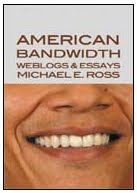 The latest appropriation of President-elect Barack Obama as artistic commodity showed up on the new cover of Time Magazine, with the POTUS-in-waiting Photoshopped as a brutha remake of Franklin Delano Roosevelt, the legendary FDR, right down to the glasses and the jaunty clench of a cigarette holder.
The latest appropriation of President-elect Barack Obama as artistic commodity showed up on the new cover of Time Magazine, with the POTUS-in-waiting Photoshopped as a brutha remake of Franklin Delano Roosevelt, the legendary FDR, right down to the glasses and the jaunty clench of a cigarette holder.There are dissimilarities, of course: Obama doesn’t wear glasses, and Michelle would beat his brains out if he walked in the house smiling behind a cigarette. But Time’s deft photo-illustration draws a comparison between the two that’s ironically less about visuals and more about emotions.
As much as he was the architect of or catalyst for any number of policies and agencies shepherded through Congress and into American life, FDR was also the empath-in-chief, responsible for imparting the idea of things being better right around the proverbial corner. The rakish angle of FDR’s signature cigarette holder was no accident; the semiotics of such a seemingly uncalculated act communicated the daring, buccaneer aspect of the American character. Relax, FDR seemed to say. We're gonna get through this. We’re gonna be all right.
Fast forward three-plus generations later. In the midst of another existential crisis for the nation, the next president emerges as the same kind of breath-of-fresh-air, a break with the past, someone we can feel good about.
◊ ◊ ◊
This in several important ways is Obama Mission #1 right now: Being Mr. Feelgood. Despite there being a need to buckle down to the hard and specific decisions involved in effectively building a government from scratch, with all the wonkish details that process requires, this may be Obama’s most important job in the sixty-seven days before he assumes the presidency and its awesome leverages.

More than the dead statistical certainty embodied in policies and metrics and bailout plans, right now the American people need a sense, a feeling that things are going to improve. They need a smile from the White House, not the calculated smirk they’ve grown unaccustomed to over the last eight years.
By and large, all world leaders are in the reaction business — responding to crises real or perceived. The special ones make more than a sideline of emotional projection, not forecasting the future but projecting their own sense of the future and communicating it, visibly and physically.
Throughout the course of a bruising presidential campaign, Barack Obama has always taken the high emotional road, maintaining an upbeat campaign ethos that has imprinted well on the national consciousness. Obama both prevailed in, and defined, the year of the underdog.
◊ ◊ ◊
 It’s been a good year for the underdog. Uno won top honors at the Westminster dog show, topping competitors to win best in show — the first beagle to do it in the Westminster's 131 years. “Juno” the movie won a best original screenplay Oscar for writer Diablo Cody. That plucky little indie movie made for chump change made more than $100 million worldwide. Juneau the city (and the state of Alaska it’s attached to) came out from nowhere onto the national media map, courtesy of Gov. Sarah Palin. (Two out of three ain’t bad.)
It’s been a good year for the underdog. Uno won top honors at the Westminster dog show, topping competitors to win best in show — the first beagle to do it in the Westminster's 131 years. “Juno” the movie won a best original screenplay Oscar for writer Diablo Cody. That plucky little indie movie made for chump change made more than $100 million worldwide. Juneau the city (and the state of Alaska it’s attached to) came out from nowhere onto the national media map, courtesy of Gov. Sarah Palin. (Two out of three ain’t bad.) The New York Giants, never thought to be in contention for ruling the football world, humiliated the New England Patriots in the Super Bowl. The Tampa Bay Rays, a team with the worst record in major league baseball last season, fought its way into this year’s World Series. From worst to first in one year.
 Americans deeply love the scrappy little challenger that could. That’s one of the reasons why, over the course of the campaign, Obama built up a reservoir of national goodwill that transcended the particularities of politics, and the raw-nerve insistence of race. He became the guy we liked. The guy we liked to like.
Americans deeply love the scrappy little challenger that could. That’s one of the reasons why, over the course of the campaign, Obama built up a reservoir of national goodwill that transcended the particularities of politics, and the raw-nerve insistence of race. He became the guy we liked. The guy we liked to like. The people of the United States have always had a wary dance with their highest authority figures, by turns accepting them and rejecting them with equal passion. The presidents we’ve revered in the past — FDR, JFK, Reagan, Clinton — found a way to inspire as well as instruct, to make us believe in the home run when all we could see was life as an unending series of grounders and foul tips.
That’s what Obama can do right now, as much as anything else before he takes office.
The new season, of course, officially starts Jan. 20, but the word from the incoming commissioner is already out: No more small ball. Next year we start swinging for the fences again.
-----
Image credits: Time cover: © 2008 Time Inc. Diablo Cody: UPI/Jim Ruymen. FDR: Detail from photo from Franklin D. Roosevelt Library.






No comments:
Post a Comment